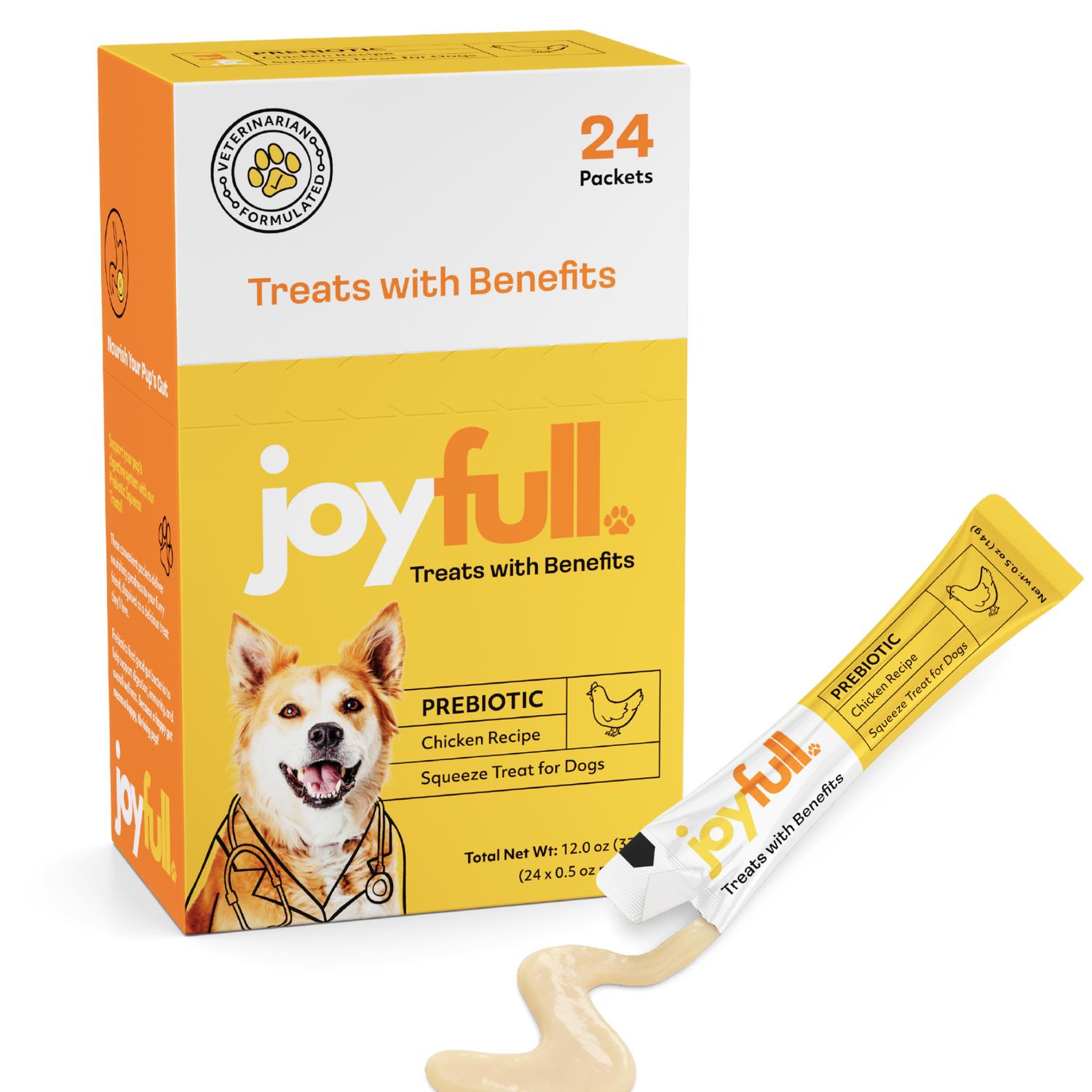
What to Look for in Dog Food A Pet Owner's Guide
When you're standing in the pet food aisle, faced with a wall of brightly colored bags, it’s easy to feel overwhelmed. I get it. To cut through the noise, here's a simple trick I use: look for a named whole protein like 'chicken' or 'beef' right at the top of the ingredient list, find the "complete and balanced" AAFCO nutritional adequacy statement, and scan for ingredients you actually recognize.
Think of that as your quick-start guide to making a solid choice for your best friend.
Your Quick Guide to Choosing the Best Dog Food
Navigating the dog food world doesn’t have to feel like you need a degree in animal nutrition. The sheer number of options out there is a direct result of a massive, booming industry. To give you some perspective, the global dog food market hit a value of around US$69.44 billion in 2024 and is expected to soar to US$99.01 billion by 2033.
What’s driving this? It's us. We're treating our pets more like family than ever before, and that means we’re demanding higher-quality, more natural ingredients in their bowls. You can actually explore more about these market trends and see what's behind this shift.
To help you understand what "high-quality" really means, the image below breaks down the core nutritional numbers for a healthy adult dog.
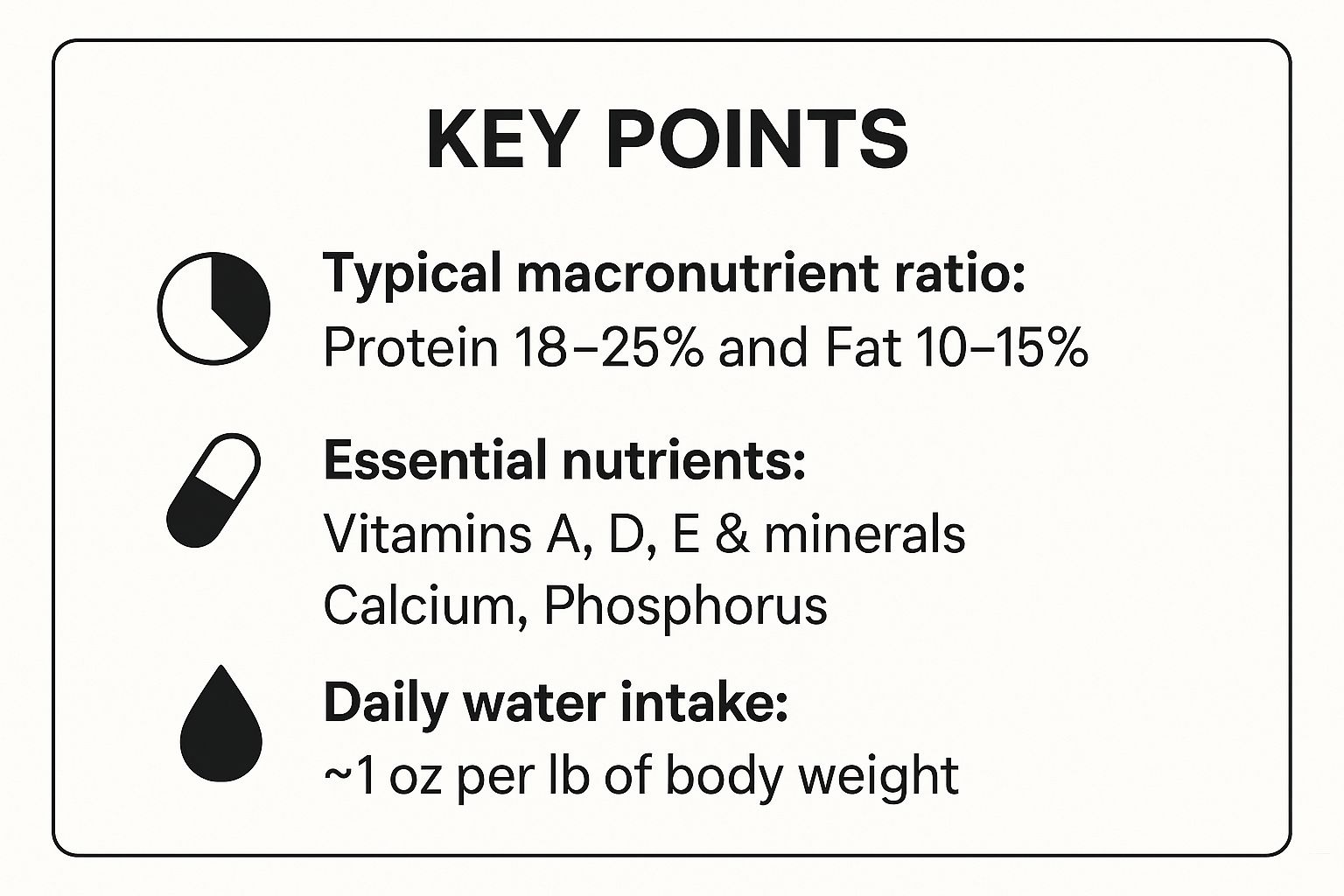
These percentages for protein, fat, and other essentials give you a solid baseline. Once you get a feel for these benchmarks, you can start looking at labels with a much more critical eye.
The 30-Second Label Check
To make your next trip to the store a whole lot easier, I’ve put together a quick reference guide. It’s designed to help you spot the good stuff (green flags) and avoid the questionable ingredients (red flags) at a single glance. Think of it as your first line of defense against a poor-quality food.
Dog Food Label Checklist Quick Reference
| What to Look For (Green Flags) | What to Avoid (Red Flags) |
|---|---|
| A named animal protein is the first ingredient (e.g., deboned chicken, lamb meal) | Vague ingredients like "meat and bone meal" or "animal fat" |
| The AAFCO "complete and balanced" statement for your dog’s specific life stage | A missing or unclear AAFCO nutritional adequacy statement |
| Whole grains, fruits, and vegetables (e.g., brown rice, peas, sweet potatoes) | Artificial colors, flavors, or chemical preservatives like BHA, BHT, or ethoxyquin |
| Natural preservatives like mixed tocopherols (a source of Vitamin E) | Unnecessary fillers like corn gluten meal or wheat gluten high on the list |
This simple comparison empowers you to quickly size up a bag of kibble before it even goes into your cart. It's all about learning to recognize quality at a glance, and this checklist is a great place to start.
Decoding the Dog Food Label Like a Pro
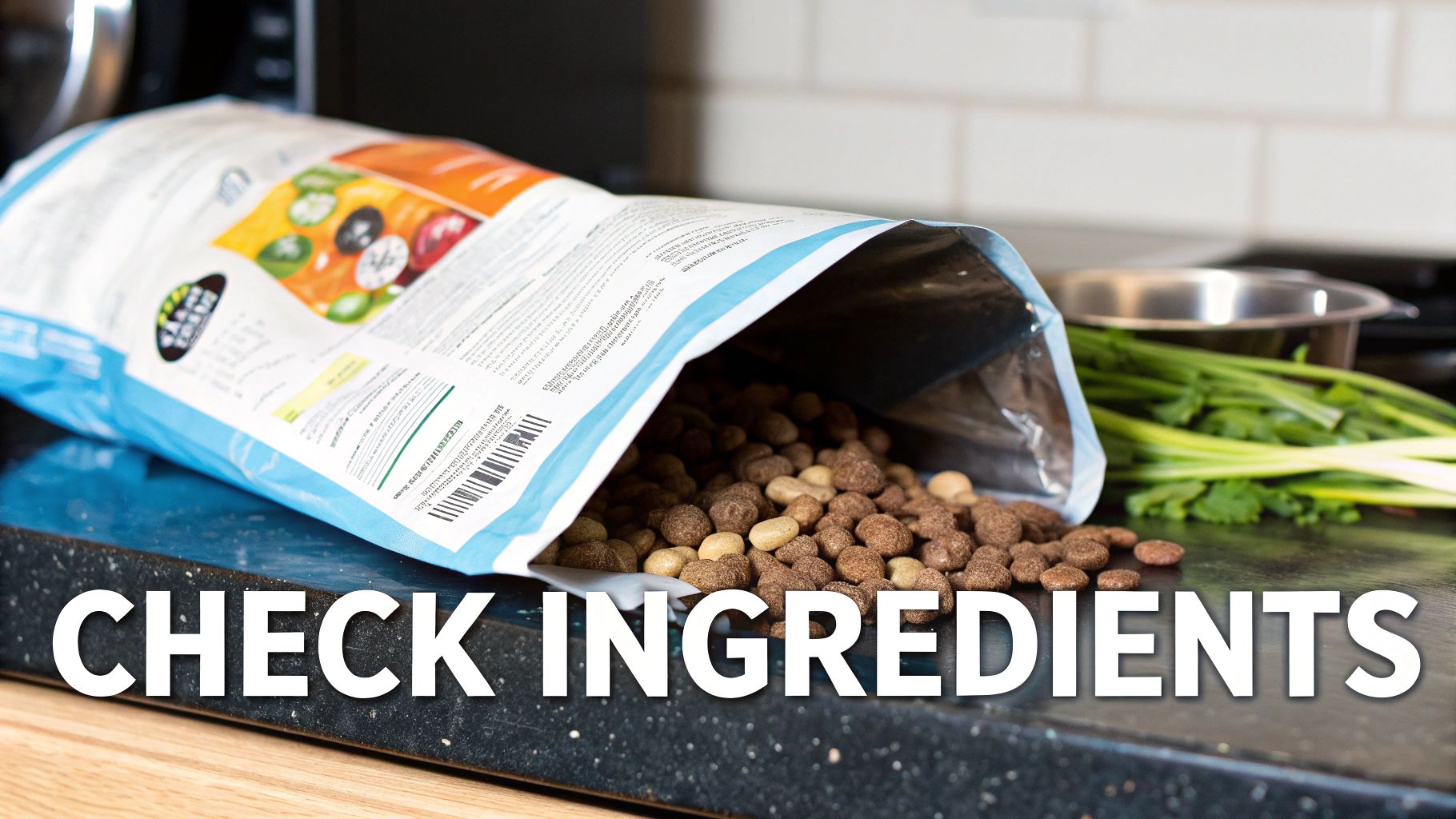
Think of a dog food label as a legal document, not a piece of marketing. Behind the flashy claims and pictures of happy dogs, you’ll find a treasure trove of clues about what’s actually inside the bag. Learning to read that label is probably the single most powerful skill you can have as a dog owner. It’s how you cut through the noise and make decisions based on solid facts.
This label is your only real window into what you're putting in your dog's bowl every day. Let's walk through the three key sections you need to master.
The Guaranteed Analysis
The first section you’ll likely spot is the Guaranteed Analysis. This is a simple chart that shows the minimum percentages of crude protein and fat, and the maximum percentages of fiber and moisture. Don't get hung up on the word "crude"—it just refers to the specific scientific method used to measure the nutrients.
Now, here’s where a lot of people get tripped up. You can't compare the percentages on a can of wet food directly to a bag of dry kibble. A canned food might list 8% protein, while a dry food boasts 27%. At a glance, the kibble looks far superior, right? Not so fast.
The real culprit here is moisture. Canned food is packed with water, often 75-80% moisture, while kibble is much drier at around 10-12% moisture. To get a true, apples-to-apples comparison, you have to mentally remove the water and look at the nutrients on a "dry matter basis."
Pro Tip: A food’s moisture content dramatically skews the nutrient percentages on the label. Always consider the dry matter values when comparing different types of dog food to understand the true nutritional content.
The All-Important Ingredient List
Next, we get to the heart of the matter: the ingredient list. This is probably the most telling part of the entire label. By law, ingredients have to be listed in descending order by their weight before cooking. That means the first few ingredients are what make up the majority of the food.
This is also where some manufacturers play clever games. A common tactic is something called "ingredient splitting." Let's say a company wants to use a lot of peas, which are cheaper than meat. Instead of listing "peas" as the second ingredient, they might list "pea protein," "pea starch," and "yellow peas" separately.
Each of those items falls lower on the list, making it seem like a quality meat ingredient is the star of the show. But if you were to add them all up, the total amount of peas could easily outweigh the meat. If you want to go deeper on this, there are great guides on how to read dog food labels that explore these tricks in more detail.
The AAFCO Nutritional Adequacy Statement
Finally, tucked away somewhere on the bag, you’ll find the AAFCO statement. The Association of American Feed Control Officials (AAFCO) isn't a government agency that approves food, but it does set the nutritional standards for the industry. This little sentence is your proof that the food is "complete and balanced" for a dog at a particular life stage.
The specific wording here is critical.
- "All Life Stages": This means the food meets the high-energy demands of a growing puppy. That also means it's packed with calories and nutrients that an adult or senior dog might not need, which could lead to weight gain.
- "Adult Maintenance": This formula is specifically balanced for adult dogs with normal activity levels. It provides all the necessary nutrition without the extra calories required for growth.
Choosing a food with the right AAFCO statement for your dog is a must. Giving an "all life stages" food to a couch-potato adult is an easy recipe for an overweight pet.
Understanding the Core Nutrients Your Dog Needs
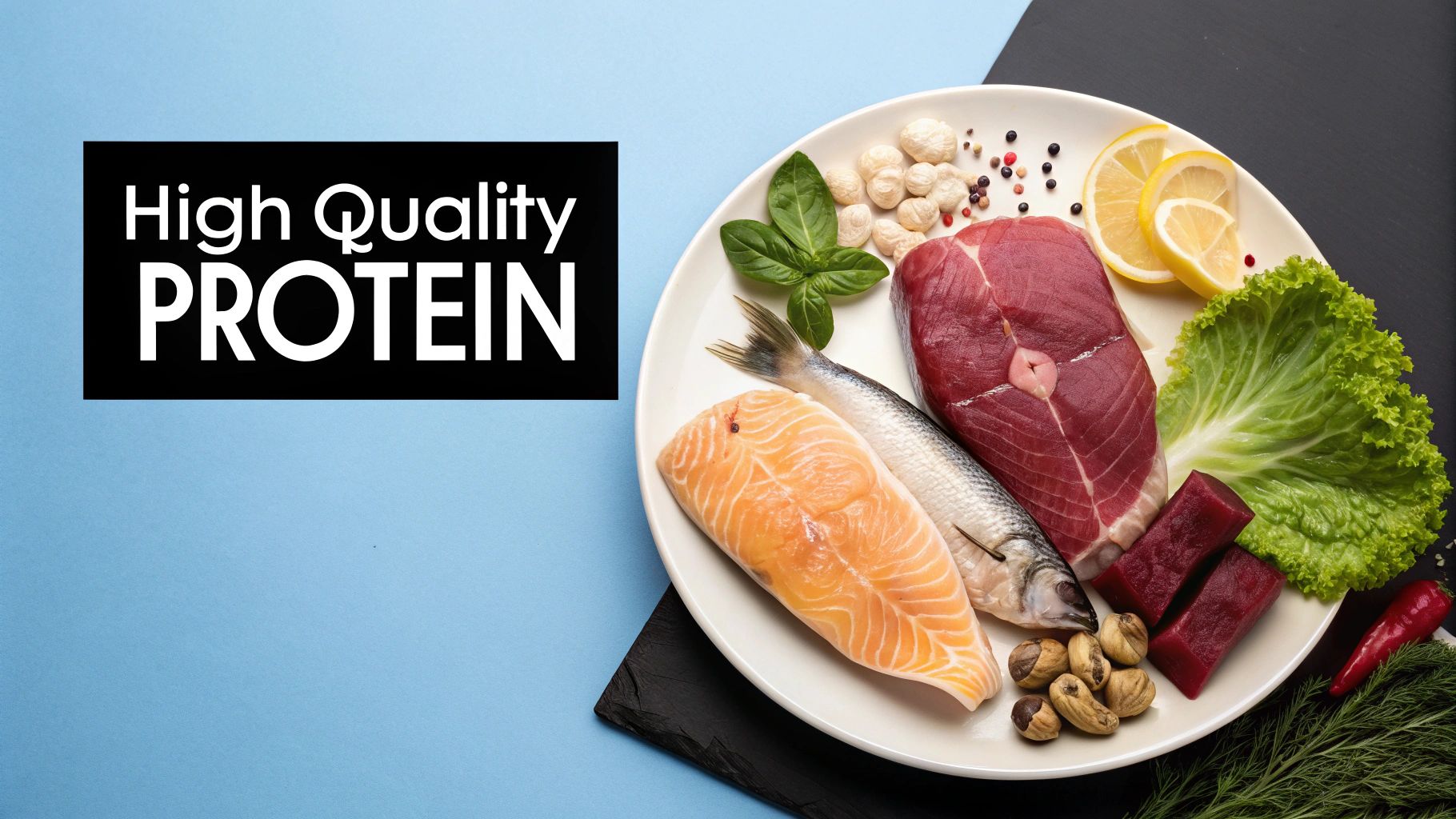
Think of building a house. You need a solid foundation, strong walls, and reliable wiring for everything to work correctly. Your dog's body is no different—it needs the right building blocks to thrive. These essential materials are the macronutrients: protein, fats, and carbohydrates.
Getting a handle on what each one does is the first real step to decoding a dog food label. It’s the "why" that gives meaning to the long list of ingredients.
Let's start with the absolute cornerstone of canine health: protein.
Protein: The Master Builder
Protein is like the master construction crew for your dog's entire body. It’s responsible for building and repairing everything from powerful muscles and internal organs to healthy skin and a thick, shiny coat. The amino acids within that protein are the individual workers on the crew, each with a very specific job to do.
But here’s the thing: not all protein sources are created equal. For dogs, the best and most valuable sources come from animals.
We call these animal-based proteins more bioavailable. In simple terms, this means a dog's digestive system can break them down and put the amino acids to work far more easily than it can with plant-based proteins. That's why you want to see real meat like chicken, beef, or fish right at the top of the ingredient list.
This demand for high-quality protein is a massive force in the pet food world. The global dog food market is projected to be worth around USD 51.27 billion by 2025, driven largely by owners seeking out foods with superior animal-derived ingredients.
Fats: The Fuel and Functional Powerhouse
Fats often get a bad rap in our human diets, but for our dogs, they are a vital, concentrated source of energy. Think of them as high-octane fuel. But their job doesn't stop there. Specific fats, namely Omega-3 and Omega-6 fatty acids, are essential for a whole range of critical bodily functions.
These healthy fats are key for:
- Brain and Eye Development: Especially important for growing puppies and for keeping senior dogs sharp.
- Skin and Coat Health: That beautiful, glossy coat? It's often a direct result of a diet rich in essential fatty acids.
- Joint Support: They play a huge role in reducing inflammation, which is a big deal for active dogs and those struggling with arthritis.
- Nutrient Absorption: Fats are the vehicle that helps your dog absorb important fat-soluble vitamins like A, D, E, and K.
When you see ingredients like fish oil (a great source of Omega-3s) or chicken fat (rich in Omega-6s) on the label, consider it a big green flag.
Carbohydrates: The Energy Source
Carbohydrates are all about providing quick, ready-to-use energy for your dog's daily zoomies and adventures. The trick is learning to spot the good guys—high-quality, complex carbs—and steer clear of the cheap, low-value fillers.
Beneficial complex carbs include ingredients like sweet potatoes, brown rice, and peas. These are digested slowly, providing a steady, sustained release of energy that prevents those dreaded sugar highs and crashes. They also pack in valuable fiber, which is fantastic for keeping their digestive system running smoothly.
On the flip side, some formulas use cheap fillers like corn and wheat gluten just to add bulk without offering much nutritional benefit. While not necessarily harmful, seeing them high up on an ingredient list can be a red flag that quality was sacrificed for cost. Choosing nutritious whole ingredients is just as important for their main meals as it is for their rewards; you can learn more in our guide on the healthiest treats for dogs.
How to Judge Real Ingredient Quality
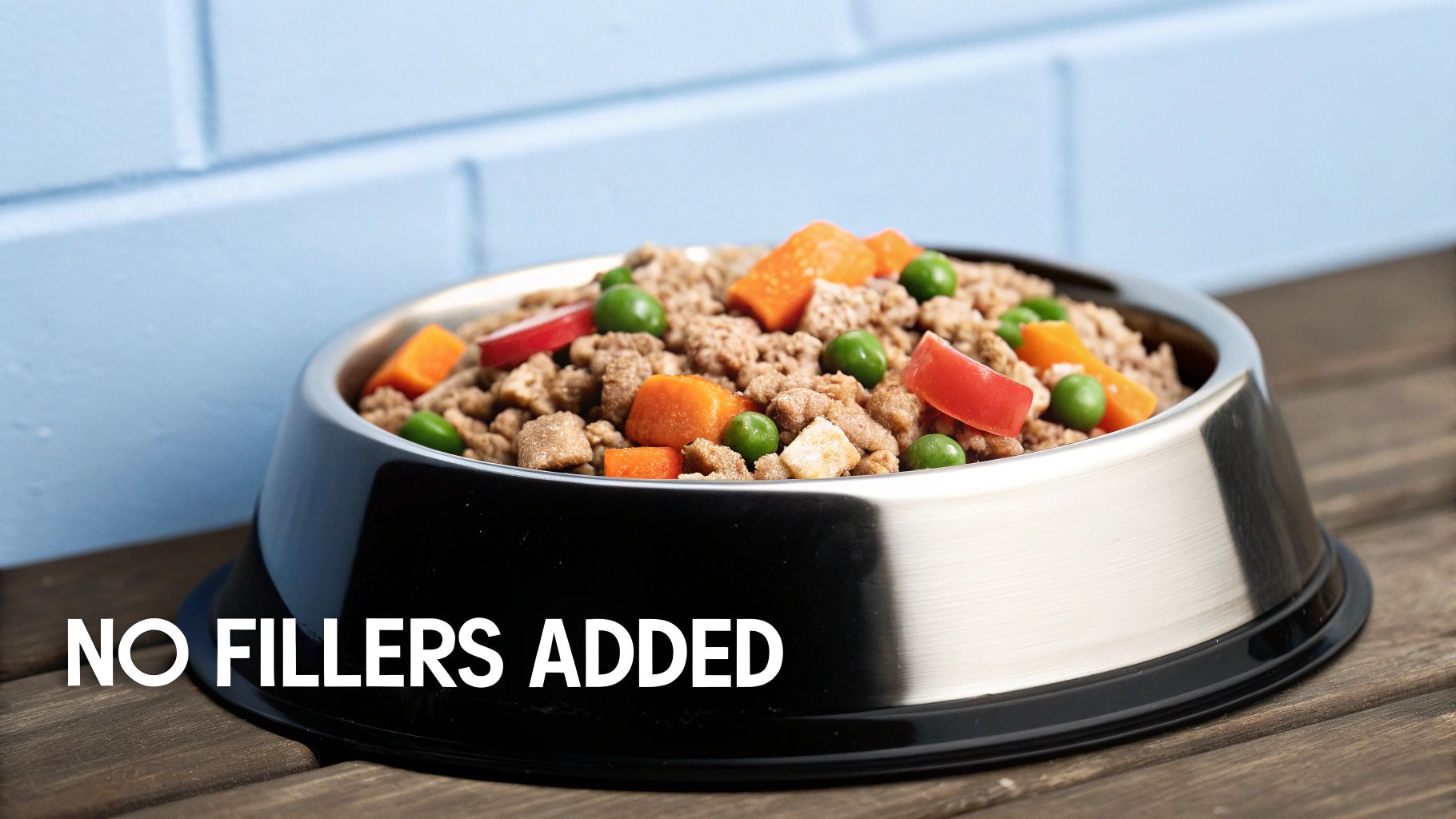
Knowing the difference between high-quality ingredients and clever marketing is a game-changer when you're standing in the dog food aisle. Let's be honest, not all proteins are created equal. Learning how to spot the genuinely good stuff on an ingredient list will make you a much better advocate for your dog's health for years to come. The secret is to look right past the pretty bag and get into the specifics.
Think of it like grocery shopping for your own family. You know there’s a world of difference between a fresh, whole chicken and a highly processed "meat product." That same logic applies directly to what goes into your dog’s bowl.
Proteins: The Good and The Vague
High-quality dog food will always put its best foot forward, featuring a named animal protein source right at the top of the ingredient list. Specificity is everything here.
What you want to see are clear, desirable ingredients like:
- Deboned Chicken: This is exactly what it sounds like—pure, wholesome meat without the bone. It's a fantastic starting point.
- Lamb Meal: Don't let the word "meal" throw you off. It simply means the protein has been rendered, a process that removes water and fat. This creates a concentrated, nutrient-dense powder. A named meal like "lamb meal" or "chicken meal" is an excellent, high-quality ingredient.
On the flip side, vague and generic terms are major red flags. These are often signs of inconsistent, low-quality ingredients sourced from materials you probably wouldn't want to think too much about.
Be on guard for formulas that list murky terms such as:
- Meat and Bone Meal: What kind of meat? From what animal? This lack of specificity means the source could change from batch to batch, and the quality is a complete mystery.
- Animal By-products: This is a legally broad term that can include a huge range of materials far less nutritious than muscle meat. While not all by-products are inherently "bad," the lack of transparency is a serious concern.
The rule of thumb is simple: if the manufacturer isn’t proud enough to name the specific animal the protein came from, you should be skeptical about its quality.
Grains, Vegetables, and Preservatives
It’s not just about the meat. The quality of the carbohydrates and preservatives tells a huge part of the story, too. Just as with proteins, you want to see whole, recognizable ingredients that add real nutritional value—not just empty calories used as cheap fillers. Look for wholesome grains like brown rice or oats and nutrient-packed vegetables like sweet potatoes and peas.
Preservatives are a necessary part of keeping food fresh and safe, but the type they use matters immensely. Natural options are always superior to artificial chemicals.
- Go-To Natural Preservatives: Look for mixed tocopherols (a natural form of Vitamin E) on the label. Ascorbic acid (Vitamin C) is another great, safe choice.
- Artificial Preservatives to Avoid: Steer clear of chemicals like BHA, BHT, and ethoxyquin. There’s been considerable debate over their potential long-term health effects, so it’s best to play it safe.
By prioritizing named meats, wholesome plants, and natural preservatives, you can see right through the marketing fluff and truly judge the quality of what’s inside the bag. This is the practical knowledge that empowers you to pick a food that will genuinely support your dog’s well-being.
Matching Food to Your Dog's Unique Profile
Ever notice how a Great Dane puppy seems to grow overnight, while a senior Chihuahua is content with a cozy nap? It’s pretty obvious they shouldn't be eating from the same bowl. Just like a professional athlete’s diet looks nothing like an accountant’s, your dog's specific needs for fuel change dramatically based on their age, breed, and how much they zoom around the backyard.
Getting this right isn't just a small detail; it's the foundation of their health. Picking the wrong food is like putting regular unleaded gas in a race car—sure, it might chug along, but it’s never going to perform its best.
This very idea of personalized nutrition is what’s driving huge changes in the pet food world. The industry is massive, valued at around US$132.4 billion in 2025, and dog food makes up over 60% of that market. A huge part of that growth comes from owners like us demanding food that’s made for our dog’s specific profile, a trend detailed in recent pet food market analyses.
Life Stage and Activity Level
A dog’s journey from a clumsy puppy to a wise old senior is marked by huge shifts in their nutritional needs. Think of each stage as having a different job, and the food is the tool they need to do it well.
Just as a person's dietary needs change from childhood to their golden years, a dog's requirements evolve significantly. Let's break down what to focus on during each key phase of their life.
Table: Nutritional Needs Across Dog Life Stages
| Life Stage | Primary Nutritional Focus | Key Ingredients to Look For |
|---|---|---|
| Puppy | Growth & Development: Building strong bones, muscles, and organs. | Higher levels of protein and calories, DHA for brain and eye development, balanced calcium and phosphorus. |
| Adult | Maintenance: Sustaining a healthy weight, energy levels, and overall bodily function. | Balanced blend of protein, fats, and carbs. Omega fatty acids for skin and coat health. |
| Senior | Preservation & Joint Support: Maintaining mobility and managing a slower metabolism. | Lower calories, high-quality protein to maintain muscle, glucosamine and chondroitin for joints, antioxidants. |
As the table shows, a "one-size-fits-all" approach simply doesn't work. The food that fuels a puppy's rapid growth is completely different from the recipe needed to support a senior dog's aging body.
And it’s not just about age. Activity level is just as important.
An active hunting dog out in the field several days a week needs a performance diet packed with extra fat and protein to keep up. Meanwhile, your average family companion who loves a good stroll around the block will do perfectly fine—and stay much leaner—on a standard adult maintenance formula.
Matching the food to their daily energy output is the best way to prevent both malnourishment and the all-too-common problem of obesity.
Breed Size and Health Concerns
The size of your dog, especially when they're a puppy, is another massive factor. A large-breed puppy like a Golden Retriever or German Shepherd has a ton of growing to do in a very short time. Their food must have a precisely controlled ratio of calcium and phosphorus to ensure their bones grow at a steady, healthy pace and to help prevent serious issues like developmental orthopedic disease.
Even the physical size of the kibble is designed with purpose. Larger kibble encourages big dogs to actually chew their food instead of inhaling it.
Of course, sometimes you're dealing with specific health challenges, and that's where specialized diets become essential.
- Allergies or Sensitivities: If your dog is constantly scratching or dealing with an upset stomach, a limited-ingredient diet (LID) can feel like a miracle. These foods have a much shorter ingredient list, which makes it far easier to figure out what’s causing the problem.
- Novel Proteins: For dogs who react to common proteins like chicken or beef, switching to a food with a novel protein—think duck, venison, or fish—can bring incredible relief. The logic is simple: they can't be allergic to something they've never eaten before.
By taking a step back and looking at the whole picture—your dog's age, size, daily routine, and any health quirks—you can move past the generic bags on the shelf and find a food that truly helps them thrive.
Answering Your Top Dog Food Questions
Diving into the world of dog food can feel like falling down a rabbit hole of conflicting advice. Even when you’ve got a handle on reading labels and understanding basic nutrients, common debates can leave even the most dedicated dog owner second-guessing their choices.
Let's clear the air. We're tackling some of the most common questions we hear from pet parents just like you. Think of this as your practical guide to cutting through the noise and making choices that you can feel good about.
Is Grain-Free Dog Food Really Better?
Honestly? Not for most dogs. The grain-free trend exploded a few years ago, but for the vast majority of our canine companions, it’s not a medical necessity. A grain-free diet is only crucial for the small slice of dogs who have a true, diagnosed grain allergy or sensitivity.
For everyone else, healthy whole grains are actually a fantastic addition to their diet. Ingredients like brown rice, barley, and oatmeal provide essential fiber, B vitamins, and a great source of energy. The real issue isn't whether a food has grains, but the overall quality of all the ingredients in the bag. A thoughtfully made, grain-inclusive food will always beat a low-quality grain-free formula.
The bottom line is to focus on high-quality, digestible ingredients, whether they include grains or not. If you're considering a major switch, especially to a grain-free diet, it’s always best to chat with your vet first.
What Is the Difference Between Wet Food and Dry Kibble?
The big differences between wet and dry food boil down to four things: water content, taste appeal, how they're made, and price. Neither one is automatically superior; the best choice really depends on your dog's unique needs, your budget, and even your lifestyle.
- Dry Kibble: This is the go-to for many owners because it's convenient, easy to store, and generally more affordable. Plus, the crunchy texture gives a little bit of a dental benefit, helping to scrub plaque off your dog’s teeth as they chew.
- Wet Food: With a moisture content often hitting 75% or more, wet food is a hydration superstar. It’s also incredibly flavorful and aromatic, which makes it a lifesaver for picky eaters, older dogs whose sense of smell might be fading, or dogs recovering from illness.
Many people find success with a "best of both worlds" strategy. Spooning a little wet food over your dog's kibble can make mealtime more exciting and sneak in extra hydration, without the higher cost of feeding an all-canned diet.
How Can I Tell if a Dog Food Brand Is Trustworthy?
A brand you can trust is one that operates with transparency and puts real science behind its formulas. Look for companies that are upfront about where they get their ingredients and where their food is manufactured. A huge green flag is seeing that they employ veterinary nutritionists or PhDs in animal nutrition to develop their recipes.
Your non-negotiable checkpoint is the AAFCO nutritional adequacy statement on the bag. This seal confirms the food is "complete and balanced" for a dog’s specific life stage. Finally, do a quick online search for the brand’s recall history. This gives you a powerful glimpse into their commitment to safety and quality control. A clean record—or a brand that handles a recall transparently—is what you want to see.
These same principles apply when choosing healthy snacks, especially for pups needing extra support. You can see how this plays out by exploring some of the best dog treats for arthritis.
At Joyfull, we believe great nutrition is the cornerstone of a happy life. That’s why we build all our recipes around clean, high-quality proteins and purposeful ingredients, all backed by our in-house veterinary advisor. We’re obsessed with making sure every bite is as nourishing as it is delicious. See the difference real food can make and find your pet's new favorite at https://joyfullpet.com.
